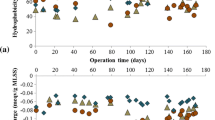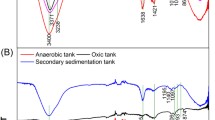Abstract
Changes in the chemical composition of organic compounds in total activated sludge, activated sludge extracellular polymeric substances (EPS), and sludge bulk water during anaerobic storage (12 days) were studied. The background for the study was that anaerobic storage of activated sludge, which often takes place at wastewater treatment plants before dewatering, causes a deterioration of the dewaterability. The reasons are not known at present, but may be related to changes in exopolymer composition of the flocs. The results showed that a fast decrease in total sludge protein and carbohydrate took place within 3 days of anaerobic storage as a result of degradation processes, which accounted for approximately 20% of the organic fraction. The amount of uronic acids and humic compounds remained almost constant in the sludge. The EPS were extracted from the floc matrix using a cationexchange resin. In the EPS matrix a similar initial (2–3 days) degradation of proteins and carbohydrate took place, whereas the content of DNA and uronic acids showed minor changes. The extractability of humic compounds increased during the first 3 days of storage. No changes in extractability of the carbohydrate were observed. A fraction of the EPS protein was found to be difficult to extract but was observed to be degraded during the anaerobic storage. The EPS composition was further characterized by high-performance size-exclusion chromatography analysis obtained by on-line UV detection and post-column detection of proteins, carbohydrates, humic compounds and DNA. Four fractions of polysaccharides were found, of which only one was responsible for the decrease in the carbohydrate content observed with storage time. The fraction was presumably of low molecular mass. Humic compounds and volatile fatty acids (acetate and propionate) were released to the bulk water from the flocs during the storage. A possible mechanism to explain the reduced dewaterability developed during anaerobic storage, partly because of the observed changes in EPS, is discussed.
Similar content being viewed by others
References
Agerbæk M, Keiding K (1995) Streaming potential during cake filtration of slightly compressible particles. J. Colloid Interface Sci 169:342–355
APHA, AWWA, WEF (1992) Standard methods for the examination of water and wastewater, 18th edn, American Public Health Association, Baltimore, Md.
Blumenkrantz N, Asboe-Hansen G (1973) A new method for quantitative determination of uronic acids. Anal Biochem 54:484–489
Box JD (1983) Investigation on the Folin-Ciocalteau phenol reagent for determination of polyphenolic substances in natural waters. Water Res 17:511–525
Brunk CF, Jones KC, James TW (1979) Assay for nanogram quantities of DNA in cellular homogenates. Anal Biochem 92:497–500
Bruus JH, Nielsen PH, Keiding K (1992) On the stability of activated sludge flocs with implication to dewatering. Water Res 26:1597–1604
Dreywood R (1946) Qualitative test for carbohydrate material. Indust Eng Chem 18:499
Eriksson L, Alm B (1991) Study of flocculation mechanisms by observing effects of a complexing agent on activated sludge properties. Water Sci Technol 24:21–28
Eriksson L, Steen I, Tendaj M (1992) Evaluation of sludge properties at an activated sludge plant. Water Sci Technol 25:251–265
Frølund B, Keiding K (1994) Implementation of an HPLC polystyrenedivinylbenzene column for separation of activated sludge exopolymers. Appl Microbiol Biotechnol 41:708–716
Frølund B, Keiding K, Nielsen PH (1994) A comparative study of biopolymers from a conventional and an advanced activated sludge treatment plant. Water Sci Technol 29:137–141
Frølund B, Gribe T, Nielsen PH (1995a) Enzymatic activity in the activated sludge floc matrix. Appl Microbiol Biotechnol (in press)
Frølund B, Palmgren R, Keiding K, Nielsen PH (1995b) Extraction of activated sludge exopolymers by a cation exchange resin. Water Res (in press)
Gjessing ET (1976) Physical and chemical characteristics of aquatic humus. Ann Arbor Science, Michigan, USA
Goodwin JAS, Forster CF (1985) A further examination into the composition of activated sludge surfaces in relation to their settlement characteristics. Water Res 19:527–533
Gray NF (1990) Activated sludge, theory and practice. Oxford University Press, Oxford
Harremoës P, Bundgaard E, Henze M (1991) Developments in wastewater treatment for nutrient removal. J Eur Water Pollut Control Fed 1:19–23
Jorand F, Zartarian F, Thomas F, Block JC, Bottero JY, Villemin G, Urbain V, Manem J (1995) Chemical and structural (2D) linkage between bacteria within activated sludge flocs. Water Res 29:1639–1647
Kintner PK, Van Buren JP (1982) Carbohydrate interference and its correction in pectin analysis using m-hydroxydiphenyl method. J Food Sci 47:756–760
Lowry OH, Rosebrough NJ, Farr AL, Randall RJ (1951) Protein measurement with the Folin phenol reagent. J Biol Chem 193:265–275
Morgan JW, Forster CF, Evison L (1990) A comparative study of the nature of biopolymers extracted from anaerobic and activated sludge. Water Res 24:743–750
Nishikawa S, Kariyuma M (1968) Nucleic acid as a component of mucilage in activated sludge. Water Res 2:811–812
Novak JT, Goodman GL, Pariroo A, Huang J-C (1988) The blinding of sludges during filtration. J Water Pollut Control Fed 60:206–214
Parker DG, Randall CW, King PH (1972) Biological conditioning for improved sludge filterability. J Water Pollut Control Fed 44:2066–2077
Rasmussen H, Bruus JH, Keiding K, Nielsen PH (1994) Observation on dewaterability and physical, chemical and microbiological changes in anaerobically stored activated sludge from a nutrient removal plant. Water Res 28:417–425
Rasmussen H, Nielsen PH (1995) Iron reduction in activated sludge measured with different extraction techniques. Water Res (in press)
Riffaldi R, Sartori F, Levi-Minzi R (1982) Humic substances in sewage sludges. Environ Pollut 3:139–146
Rudd T, Sterrit RM, Lester JW (1983) Extraction of extracellular polymers from activated sludge. Biotechnol Lett 5:327–332
Ryssov Nielsen H (1975) The role of natural extracellular polymers in the bioflocculation and dewatering of sludge. Vatten 1:33–39
Starkey JE, Karr PR (1984) Effect of ion dissolved oxygen on effluent turbidity. J Water Pollut Control Fed 56:837–843
Sørensen PB, Hansen JAa (1993) Extreme compressibility in biological sludge dewatering. Water Sci Technol 28:133–144
Sørensen BL, Wakeman RJ (1995) Filtration characterisation and specific surface area measurements of activated sludge by rhodamine B adsorption. Water Res (in press)
Urbain V, Block JC, Manem J (1993a) Bioflocculation in activated sludge: an analytical approach. Water Res 27:829–838
Urbain V, Pys E, Block JC, Manem J (1993b) Composition and activity of activated sludge under starvation conditions. Environ Technol 14:731–740
Vallom JK, McLoughlin AJ (1984) Lysis as a factor in sludge flocculation. Water Res 18:1523–1528
Wetzel RG (1991) Extracellular enzymatic interactions: storage, redistribution and interspecific communication. In: Chróst RJ (ed) Microbial enzymes in aquatic environments. Springer, New York Berlin Heidelberg, pp 6–28.
Zita A, Hermansson M (1994) Effects of ionic strength on bacterial adhesion and stability of flocs in a wastewater activated sludge system. Appl Environ Microbiol 60:3041–3048
Author information
Authors and Affiliations
Rights and permissions
About this article
Cite this article
Nielsen, P.H., Frølund, B. & Keiding, K. Changes in the composition of extracellular polymeric substances in activated sludge during anaerobic storage. Appl Microbiol Biotechnol 44, 823–830 (1996). https://doi.org/10.1007/BF00178625
Received:
Revised:
Accepted:
Issue Date:
DOI: https://doi.org/10.1007/BF00178625




